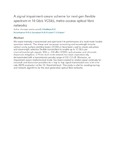A signal impairment-aware scheme for next-gen flexible spectrum in 10 Gb/s VCSEL metro-access optical fibre networks
| dc.contributor.author | KiboiBoiyo, D. | |
| dc.contributor.author | Kipnoo, E.K. R. | |
| dc.contributor.author | Gamatham, R.R.G. | |
| dc.contributor.author | Leitch, A.W.R. | |
| dc.contributor.author | Gibbon, T.B. | |
| dc.date.accessioned | 2018-11-20T05:58:36Z | |
| dc.date.available | 2018-11-20T05:58:36Z | |
| dc.date.issued | 2017-07 | |
| dc.identifier.uri | https://www.sciencedirect.com/science/article/abs/pii/S157342771630100X?via%3Dihub | |
| dc.identifier.uri | http://ir.mksu.ac.ke/handle/123456780/1792 | |
| dc.description.abstract | We experimentally characterized and optimized link performance of a multi-node flexible spectrum network. The cheap and low power consuming and wavelength tunable vertical cavity surface-emitting lasers (VCSELs) have been used to create colourless and wavelength selective flexible transmitters to enable up to 10 Gb/s per channel/wavelength signals. With a −3.8 dBm VCSEL optical power and chromatic dispersion mitigation, a 25 km multi-node network has been experimentally demonstrated with a transmission penalty range of 0.2–3.2 dB. Moreover, an impairment-aware mathematical model has been created to predict signal continuity for crosstalk and dispersion penalties for a hop-to-hop signal transmission and a bit errorrate (BER) evaluation at the 10-9 threshold level. This study is vital for creating routing and network algorithms for the next-generation optical fibre networks. | en_US |
| dc.language.iso | en_US | en_US |
| dc.publisher | Elsevier | en_US |
| dc.title | A signal impairment-aware scheme for next-gen flexible spectrum in 10 Gb/s VCSEL metro-access optical fibre networks | en_US |
| dc.type | Article | en_US |
Files in this item
This item appears in the following Collection(s)
-
School of Pure and Applied Sciences [259]
Scholarly Articles by Faculty & Students in the School of Pure and Applied Sciences

